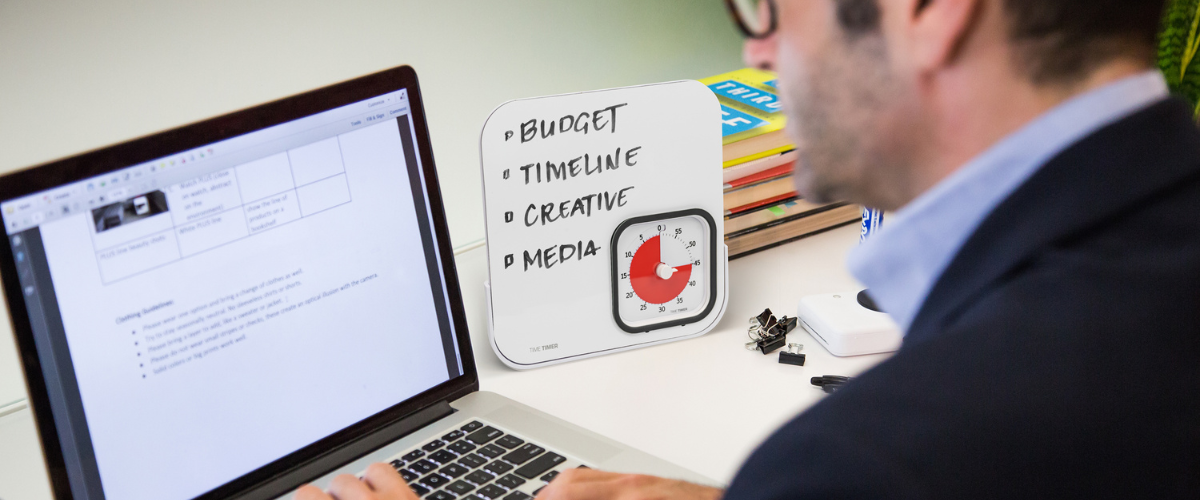Using Time Timer Products to Support Back-to-School Routines and Set Students Up for Success
Back-to-school season is a fresh start filled with potential for big changes. New classrooms, unfamiliar routines, shifting expectations, and a wide range of student needs can make August and September overwhelming for students and teachers.
This crucial period can benefit from introducing Time Timer's low-tech visual timers that turn the abstract concept of time into a concrete visual experience.
Implementing a Time Timer visual timer on day one can dramatically smooth classroom transitions, reduce anxiety, build independence, and help set classroom routines that stick.
Using Time Timer products consistently during the first few weeks of school can make all the difference when managing time and transitions in the classroom throughout the rest of the school year.
Classroom Transitions Matter at the Start of the Year
Transitions involve stopping a current task, mentally preparing for the next, and physically moving; all while managing time and emotional regulation.
Students of all ages, especially younger children and those with executive-functioning challenges, can have difficulties with classroom transitions.
Back-to-school weeks can heighten these difficulties:
- Adjusting to new rules, peers, and environments
- Establishing routines
- Teachers getting to know students and assess needs; students learning teachers' teaching style
- Escalation of academic tasks and classroom expectations
Time Timer: A Visual Anchor in Times of Transition
Our visual timers display an elapsing disk that visibly disappears as time elapses. This visual cue helps students see time rather than merely track it. This visual anchor reminds students what’s happening now, what’s coming next, and how long they have to prepare.
It’s especially effective for:
- Students who struggle with executive functioning
- Neurodivergent students, especially those with ADHD, autism spectrum disorder (ASD), or anxiety
- English Language Learners (ELLs)
- Young children learning time concepts
Step-by-Step: How to Implement Time Timer Visual Timers at the Start of the School Year
- Introduce It Early, Explain the “Why”: Start by showing it to the class and explaining how it shows us how much time we have left for an activity. As the red gets smaller, time is passing; when the red is gone, we switch to the next activity. The earlier you introduce it the sooner the students associate it with classroom structure.
- Use the Timer for Every Transition: Arrival and unpacking, morning meeting, independent-work blocks, group rotations or centers, snack and lunch prep, clean-up and dismissal, lining up or moving between rooms.
- Verbal Cues for Predictability: Pair visual countdowns with auditory cues. This can help students better associate where the elapsing disk is with a time.
- Use Multiple Timers to Differentiate: A large timer for whole-class transitions and personal timers or the Time Timer App for individual work or breaks can more generally develop students' time-management skills.
Time Timer App Enterprise Edition: Extending the Routine Beyond the Wall
Classrooms with access to devices can benefit from the Time Timer App Enterprise Edition, which allows schools to offer our app to the student population.
This app allows students to extend classrooms' visual routines beyond the front of the room, even being able to bring the app home with them on their phones for help with homework and studying.
This mirrors the same signature visual experience of the physical Time Timer visual timers, but on tablets, laptops, or smartphones.
Benefits include:
- Setting personal timers during independent-work periods
- Manage multiple timers simultaneously, which is useful for group activities or multi-step tasks
- Schools can use it from classroom to classrooms
Using both physical Time Timer visual timers and the Time Timer App Enterprise Edition creates a unified system.
Whether a student is working at a desk at school or doing remote homework at the kitchen table at home, the elapsing disk looks the same and provides the same calming structure.
Troubleshooting Common Challenges
- Students ignore the timer: Make clear your expectations and use praise to reinforce when students respond quickly.
- Transitions still take too long: Use shorter frequent timers during practice and consider timing the transition itself.
- Time anxiety in students: Let students know the timer's there to help them, not stress them. In sensitive cases, position the timer in a place where it can be seen, but is not overwhelming or feels central to the activity.
By the end of the first week, students will already start internalizing these timeframes and cues.
Time Timer Products for Education
We offer a variety of visual timers fit for many different classrooms. We are proud that our products can be useful at every grade level as well as in special-needs classrooms.
Accessibility matters to us, so even for students with visual impairments, we offer a Time Timer visual timer with Braille that is readable to such students.
Have any questions for us about the Time Timer product line? Check out our help page!





